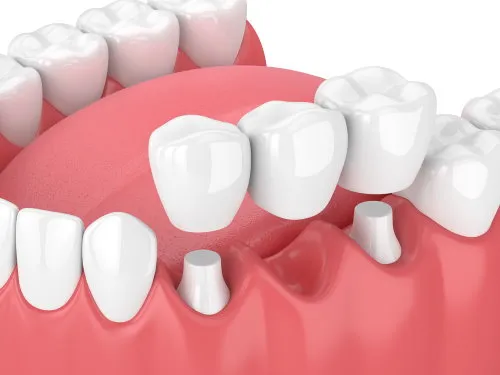
Permanent Dental Bridge
A permanent dental bridge is a fixed dental restoration used to replace one or more missing teeth. Unlike removable dentures, a dental bridge is cemented or bonded in place and cannot be removed by the patient. It is a long-term solution that provides functional and aesthetic benefits.
Fixed Restoration: A permanent dental bridge is fixed in place, meaning it is not removable by the patient. Once it is securely bonded or cemented, it becomes a stable part of the patient’s oral anatomy.
- Traditional Bridge: The most common type, consisting of dental crowns on the adjacent teeth (abutments) with artificial teeth (pontics) in between.
- Cantilever Bridge: Supported by a dental crown on only one side.
- Maryland Bridge (Resin-Bonded Bridge): Uses metal or porcelain wings bonded to the back of adjacent teeth, avoiding the need for crowns.
- Porcelain-Fused-to-Metal (PFM): Combines the strength of metal with the aesthetics of porcelain.
- All-Ceramic or All-Porcelain: Provides a natural appearance without any metal components.
The process typically involves two or more dental appointments.
- During the first appointment, the adjacent teeth (abutments) are prepared by removing a portion of their enamel to accommodate the crowns that will hold the bridge.
- Impressions are taken to create a mold for the bridge.
- A temporary bridge may be placed to protect the prepared teeth.
- In the subsequent appointment, the custom-made bridge is fitted, adjusted, and permanently cemented in place.
- Restores the ability to chew and speak properly.
- Maintains facial aesthetics and the alignment of natural teeth.
- Prevents remaining teeth from shifting out of position.
- Provides a long-lasting and stable solution for missing teeth.
- Regular oral hygiene practices, including brushing and flossing, are crucial for maintaining the health of the bridge and surrounding teeth.
- Regular dental check-ups are important to monitor the condition of the bridge and address any issues promptly.
Longevity:
- The lifespan of a permanent dental bridge depends on factors such as oral hygiene, materials used, and the location in the mouth. With proper care, bridges can last for many years.
- The lifespan of a permanent dental bridge depends on factors such as oral hygiene, materials used, and the location in the mouth. With proper care, bridges can last for many years.
Permanent dental bridges are a common and effective option for replacing missing teeth. However, their suitability depends on individual factors, and consultation with a dentist is necessary to determine the best treatment plan for each case.
